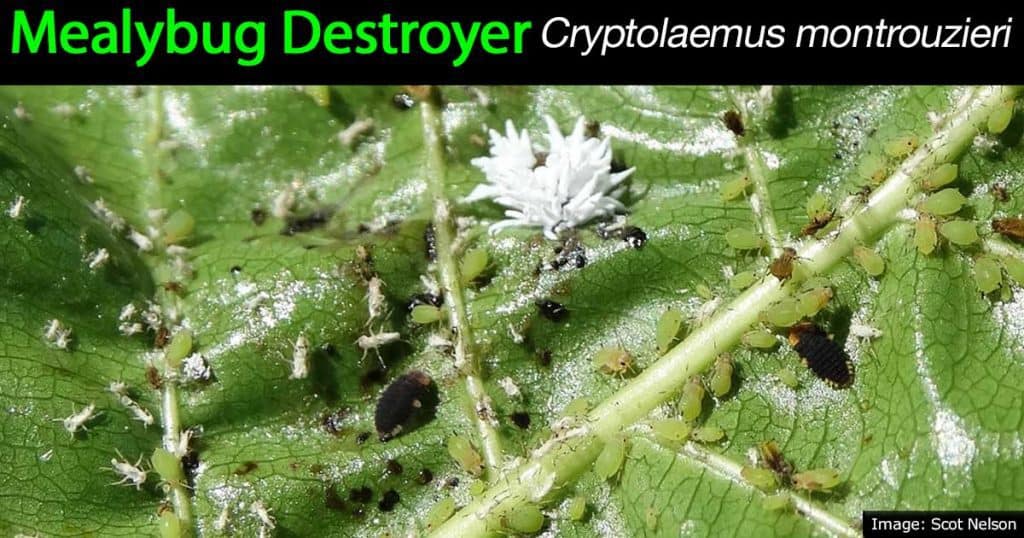Cryptolaemus montrouzieri may be a handful of words for an insect, but those who work in the gardens know it by their more familiar name and trait – Mealybug Destroyer!
The “Crypts” resemble the ladybug, and were therefore named the ladybug beetle, lady beetle or ladybird beetles. The similarity ends there, as the lady beetle is not known to aggregate or to disappear when released.
The Mealybug Destroyer An Appetite For Pests!
The ladybird beetle’s appetite for pests are almost equal to none. These “Crypts” love to dine on mealybugs, most especially their youngs making ladybird beetles their natural enemies!

Once cleaned, these beneficial insects turn their heads to other pests on plants in the garden and can eat scale bugs in the crawler or immature form, insect eggs and more.
This might seem to be an added bonus, but experts recommend against releasing Mealybug Destroyers to eliminate pests other than mealybugs.
How To Use Ladybug Beetles In The Garden
The adult female Mealybug Destroyer lays her eggs in the cotton-like masses mealy bugs produce, usually one egg per mass. She will then move to the next cotton-like mass and put in another egg, effectively “plant” her young.

She lays approximately 10 eggs a day for 50 days. The Crypt’s eggs hatch and out comes a hairy larvae that looks like a mealybug.
They grow up to 1 cm. in length and are already voracious predators, feeding on mealybugs their size and always eating the most succulent youngs first.
Ladybird Beetles Growth Stage
The growth stage of the ladybird beetle is as follows:
- Immature during the first 3 weeks
- They spend a month in the adult stage

The ladybird beetle is characterized by its copper-coloured head and a glistening black body. Their thoraxes are of dull orange hue.
They love a climate temperature of somewhere between 64° to 91° degrees Fahrenheit, but will thrive in less than optimal conditions.
Keep in mind that fluctuations in humidity and/or temperature change may alter development or reproduction to certain degrees.
The Evidence Of The Mealybug Destroyer Hard At Work In The Garden
You’ll see evidence of these hard-working predators with:
- Exploded mealy bug egg nests
- Significantly reduced mealybug population
- Absence of mealy bug at its larval stages
- The emergence of adult Crypts

Remember it all starts with the laying of eggs in the cottony masses.
How Do They Work Against Long-tailed Mealybugs?
The long-tailed mealybug gives live-birth to their young, not needing any cotton-like masses from which the Ladybug Beetle can lay her egg.
If your garden has more than one mealybug species, the Ladybug Beetle can work to eliminate pest in said conditions (as long as there’s the egg masses).
Alternative Options For Controlling The Long-Tailed Mealybug
Want to use a different biological control apart from the Cryptolaemus when keeping the long-tailed mealybug at bay?
There are some alternate options. For one, you can deploy some Green Lacewings or the Chrysoperla spp. in your garden.
They’ll do a wonderful job in exterminating the mealybugs in the area!

Make use of the larvae for maximum satisfaction; adult lacewings may spend extra time trying to locate the colonies, but larvaes and eggs that spawn on-site immediately start the mealybug control.
You may also put in tiny pieces of synthetic quilt batting in the long-tailed mealybug infestation.
Avoid the use of cotton balls if necessary, since they could contain traces of insecticides. Try placing halved 3″ by 5″ index cards to lure the beetles within the mealybug populace.
Encouraging Mealy Bug Destroyers To Feast On The Long-Tailed Mealybugs
If you already have some “Destroyers”, there are some methods to try and encourage them to feast on the long-tailed mealybugs.
Try misting the infested area with water before releasing the Crypts into your garden.

The Ladybug Beetle loves pollen from flowers, as well as mealybug honeydew. They even enjoy lunching on root mealybugs.
Having those in your garden is a big plus to keep them around for longer.
Keep The Ant Population Down
Try to keep the ant population down because they defend the mealybugs for their food source – the honeydew. Employ boric acid or barrier products to control them.
Last but not least, don’t wear white whenever you release the mealy bug destroyers out in the wild.
They are attracted to white and might leave their posts to go after you. Remove any sticky traps if you’re catching too many beetles, or use them only a few days a week.
Purchasing Mealybug Destroyers
These bug warriors may be bought (amazon) from shops in their insectary-reared, pre-mated and pre-fed form. Some of the Crypts’ favorite mealybug meals are:
- Maconellicoccus hirsutus – the pink hibiscus mealybug – known to attack Allamanda, Anthurium, Bougainvillea, varieties of Croton, Heliconia, Ixora, hibiscus trees and shrubs, palm, and oleander.
- Phenacoccus gossypii – the Mexican mealybug
- Phenacoccus solenopsis – the Solenopsis mealybug
- Pseudococcus obscures – the Obscure mealybug
- Pseudococcus comstocki – the Comstock mealybug
- Planococcus citri – Citrus mealybug

The Mealybug Destroyer can also consume the Pseudococcus longispinus, or the long-tailed mealybug if they are present with other pests that produce cotton-like eggs.
image: Scot Nelson via Flickr
